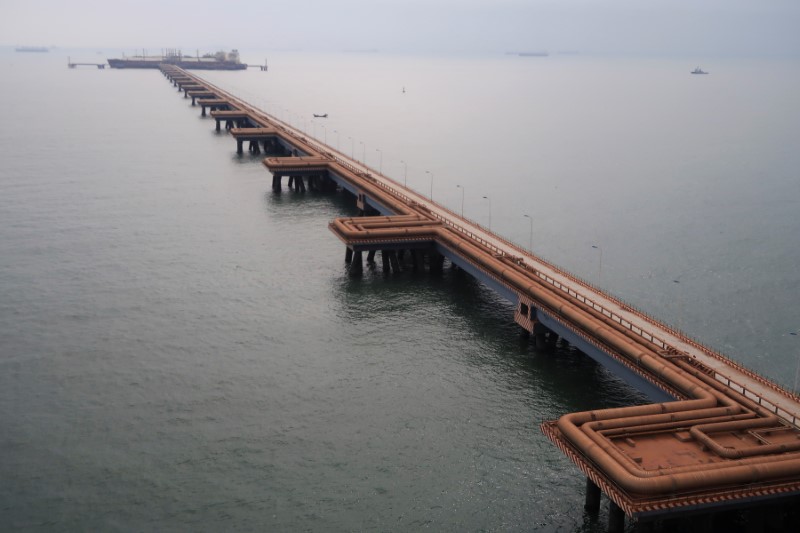By Vladimir Soldatkin
MOSCOW (Reuters) – Kremlin-owned energy kingpin Gazprom (MCX:), once Russia’s most profitable company, could face a long period of poor performance as it struggles to fill the gap of lost European gas sales with its domestic market and Chinese exports.
The company recently reported an annual net loss of $7 billion, its first since 1999, after a sharp decline in trade with Europe.
Gazprom’s problems reflect the deep impact that European sanctions have had on Russia’s gas industry, as well as the limitations of Moscow’s growing partnership with China.
The impact of international sanctions on oil exports is easier for Moscow to absorb because Russia has been able to shift oil exports by sea to other buyers.
Gazprom relied on Europe as its largest market until 2022, when Russia’s conflict with Ukraine prompted the EU to reduce imports of Gazprom gas.
Russia delivered a total of around 63.8 billion cubic meters (bcm) of gas to Europe through various routes in 2022, according to Gazprom data and Reuters calculations. The volume fell further last year, by 55.6%, to 28.3 billion cubic meters.
That compares with a peak of 200.8 billion cubic meters that Gazprom pumped to the EU and other countries such as Turkey in 2018.
Mysterious explosions at the undersea Nord Stream gas pipelines from Russia to Germany in September 2022 have also significantly undermined Russia’s gas trade with Europe.
Russia has turned to China in a bid to boost pipeline gas sales to 100 billion cubic meters per year by 2030. Gazprom started supplying gas via pipelines to China via the Power of Siberia at the end of 2019.
Remove ads
.
It plans to reach Power of Siberia’s annual capacity of 38 billion cubic meters by the end of this year, while Moscow and Beijing also agreed to export 10 billion cubic meters from Sakhalin Island in the Pacific in 2022 Ocean.
Russia’s biggest hope is the Power of Siberia 2 pipeline via Mongolia, which is expected to export 50 billion cubic meters per year. But that has presented some pitfalls due to the lack of agreement on prices and other issues.
“While Gazprom will see some additional export revenues once all those pipelines are operational, it will never be able to fully compensate for the revenue it has lost to Europe,” said Kateryna Filippenko, gas and LNG research director at Wood Mackenzie. said.
CHINESE PIPE DREAM?
Russia has also so far struggled to establish a gas trading center in Turkey, an idea first mooted by President Vladimir Putin in October 2022. No significant development has been reported since.
Even if Gazprom can get its pipeline supplies flowing to China, sales revenues will be much lower than those from Europe.
According to Moscow-based BCS brokerage, Gazprom’s revenues from gas sales to Europe averaged $3.3 billion per month during 2015-2019, thanks to monthly deliveries of 15.5 billion cubic meters.
Taking into account a price of $286.9 per 1,000 cubic meters, as reported by the Russian Ministry of Economic Affairs, and Gazprom’s gas exports of 22.7 billion cubic meters last year, the total value of the company’s gas sales to China for all of 2023 could amount to $6.5 billion. .
Remove ads
.
Gazprom has not separately disclosed its revenue from sales to Europe or China for 2023.
Dr. Michal Meidan, head of China Energy Research at the Oxford Institute for Energy Studies, said China is unlikely to replace Europe with Russia as a highly profitable gas export market.
“China gives Russia a market, but at much lower prices and revenues than Europe,” she said.
In 2023, gas from the Russian pipeline was sold at $6.6 per million British thermal units (mmBtu) to China and slightly lower than that in the first quarter of 2024 at $6.4/mmBtu.
That compares with an average price of Russian gas in Europe of $12.9/mmBtu last year.
According to a document seen by Reuters last month, Russia expects gas prices for China to continue to fall gradually over the next four years, while a worst-case scenario does not rule out a 45% drop to $156.7 per 1,000 cubic meters (about $4.4 per 1,000 cubic meters). mmBtu) in 2027 versus 2023.
It did not say what could drive down prices, but Russia faces rivalry from other suppliers of pipeline gas to China, such as Turkmenistan, and liquefied gas shipped by sea.
The financial figures of Gazprom, which also includes oil and electricity companies, show that revenues from the natural gas sector more than halved last year, to just over 3.1 trillion rubles, while sales of oil and gas condensate amounted to 4.1 trillion rubles, an increase of 4.3 trillion rubles. %, according to BCS brokerage.
Alexei Belogoriyev of the Moscow-based Institute of Energy and Finance said it would be impossible for Gazprom to restore profitability by relying solely on its gas business.
Remove ads
.
He said a strategic shift to the production and export of ammonia, methanol and other gas processing products for Gazprom is possible, but it will not bring quick returns.
“At the same time, the prospects for Power of Siberia 2 remain vague: China will most likely not need as many additional imports in 2030 due to the likely slowdown in demand growth and high domestic gas production,” he said.


